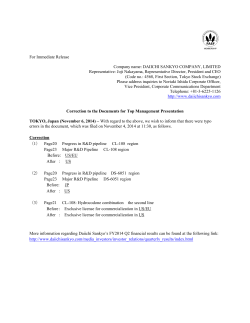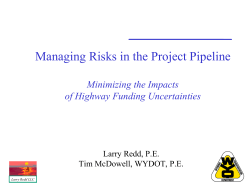
Delmont Presentation
Community Impacts of Mariner East Pipeline Prepared for Delmont Public Library Meeting Delmont, PA July 30, 2014 Presented by Sam Koplinka-Loehr, Clean Air Council Presentation Overview • Introduction • Mariner East Background • Pumping Station Specifics • Air Pollutants and Public Health • Jobs Revisited Photo Source: Bob Donnan: http://www.donnan.com/EPA_Air-Quality_92711.htm Clean Air Council Marcellus Shale Program • • • • Track current rulemaking and write comments on regulations Work with residents to comment and testify on natural gas infrastructure Lawsuits against polluters or agencies Community actions to achieve goals outside of regulatory pathways 64% of PA is above Marcellus Shale. In 2013, PA had over 6,000 wells with 3 trillion cubic feet of gas production. These gas products have flooded regional markets and companies are trying to build pipelines to sell overseas. Mariner East 1 Mariner East 1 Basics • New Pipeline 50 miles Western PA • Existing Pipeline 300 miles Over 80 years old Oldest pipelines 4% Source: 4% of US gas transmission pipelines were built before 1940 Canary LLC CEO Dan Eberhart http://canaryusa.com/aging-us-pipelines/ Sunoco Logistics’ Plan • Switch the pipeline direction to pump natural gas liquids from wells near Houston, PA to the Marcus Hook Refinery near Philadelphia • Increase pressure from 800 pounds per square inch (PSI) to 1400 PSI • 18 new pumping stations and 17 new valve control stations • 70,000 barrels per day, as of 2015 all will be destined for export to gulf coast and overseas Natural Gas Liquids - Ethane • Mariner East will transport 100% ethane as of 2015 • Extracted as gas, but under pressure becomes a liquid • Used industrially for plastics, anti-freeze, and detergents • Extremely flammable Public Utility Commission (PUC) • Sunoco Logistics has been a “public utility” since 2002 • Two simultaneous issues – Western PA: Eminent Domain to construct new pipeline – Eastern PA: Exemption from local zoning laws for stations • Current PUC process will determine whether or not pumping stations are “reasonably necessary for the convenience and welfare of the public” Sunoco Logistics Pipeline Incidents Source: PHMSA, Pipeline and Hazardous Materials Safety Administration. http://primis.phmsa.dot.gov/comm/ reports/operator/OperatorIM_opid_18718.html?nocache=259#_OuterPanel_tab_2 This is Just the Beginning: Mariner East 2 and 3 Sunoco Logistics Claims: • Mariner East 1 will be operational by Fall 2014 • Mariner East 2 will be operational by 2016, capacity of at least 50,000 barrels/day • Mariner East 3 will follow thereafter Pumping Stations Pumping Stations Emission Sources at Pumping Stations • Electric Pump Motors • Flaring of gas during maintenance operations and constant flaring of fugitive emissions Source: Data and images from State-only operating permit filed with DEP Flare Design Fugitive Emissions/Leakages Leakage from Compressor Stations. Source: EPA Flare Volume • Maximum expected annual flaring: – 312,800 standard cubic feet – Equivalent to 8,696 gallons – 23 gallons daily • Could be more if there are maintenance issues Flare Frequency • Flare will operate 24/7, igniting fugitive emissions from the motor and pipeline seals Fugitive Emissions: Volatile Organic Compounds (VOCs) • Equal to 5 constantly idling school buses Carbon Emissions • 35.8 tons of carbon annually, equal to: – Annual carbon sequestration from 26 acres of forest – Burning 34,884 pounds of coal Health Impacts from Pollutants Pollutants from Shale Gas Infrastructure Dallas Fort Worth In 2009, the gas industry released more smog-forming emissions than all cars and trucks in the Dallas metro area – New York Times article citing Armendariz’s 2009 report, supported by Texas Commission on Environmental Quality http://www.nytimes.com/gwire/2011/05/27/27greenwire-could-smog-shroud-the-marcellus-shales-natural-3397.html?pagewanted=all RAND 2013 Air Pollution Study • Research and Development finds shale gas air pollution damages already between $7.2 and $30 million in PA. – Health damages: increased asthma, hospitalization, premature death. – Physical damages: agriculture and infrastructure. Source: http://www.rand.org/pubs/external_publications/EP50160.html Potential Health Impacts from Ozone • Ozone forms from VOC and NOx in the present of sunlight • Aggravation of asthma, bronchitis & emphysema and increased susceptibility to pneumonia & bronchitis • Linked to bladder, breast, and lung cancers, stroke, diabetes, lung damage, and premature death • Throat irritation, congestion, coughing, and chest pain Source: http://www.epa.gov/air/ozonepollution/health.html American Lung Association, “Health Effects of Ozone and Particle Pollution,” State of the Air, 2011; President’s Cancer Panel, Reducing Environmental Cancer Risk: What We Can Do Now, 2008-2009 Annual Report (National Cancer Institute, May 2010). Cumulative Health Impacts • Taken together, emissions from shale gas infrastructure have substantial public health ramifications. – In their 2013 study, Lisa McKenzie et al. found elevated risk of birth defects in populations residing within ten-miles of gas wells. – Pennsylvania Auditor General July report says DEP “unprepared” to monitor gas from fracking – DOH Employee silencing using list of “codewords” including “Marcellus Shale,” “fracking” Source: L. McKenzie http://ehp.niehs.nih.gov/1306722/#tab2 Jobs & Alternative Energy Pennsylvania Alternative Energy Portfolio Standards • Standard dictates 8 percent of Pennsylvania Energy to come from renewables by 2021 Source: http://cleanenergywins.org/wp-content/uploads/2014/03/CleanEnergyWins_PolicyRoadmap.pdf US Solar Source: http://www.thesolarfoundation.org/sites/thesolarfoundation.org/files/TSF%20Solar%20Jobs%20Census%202013.pdf PA Solar • Out of state credits • Market glut • Fossil fuel industry lobbying Contact Info • Sam Koplinka-Loehr, CAC Shale Gas Organizer SKL@cleanair.org Questions?
© Copyright 2025















